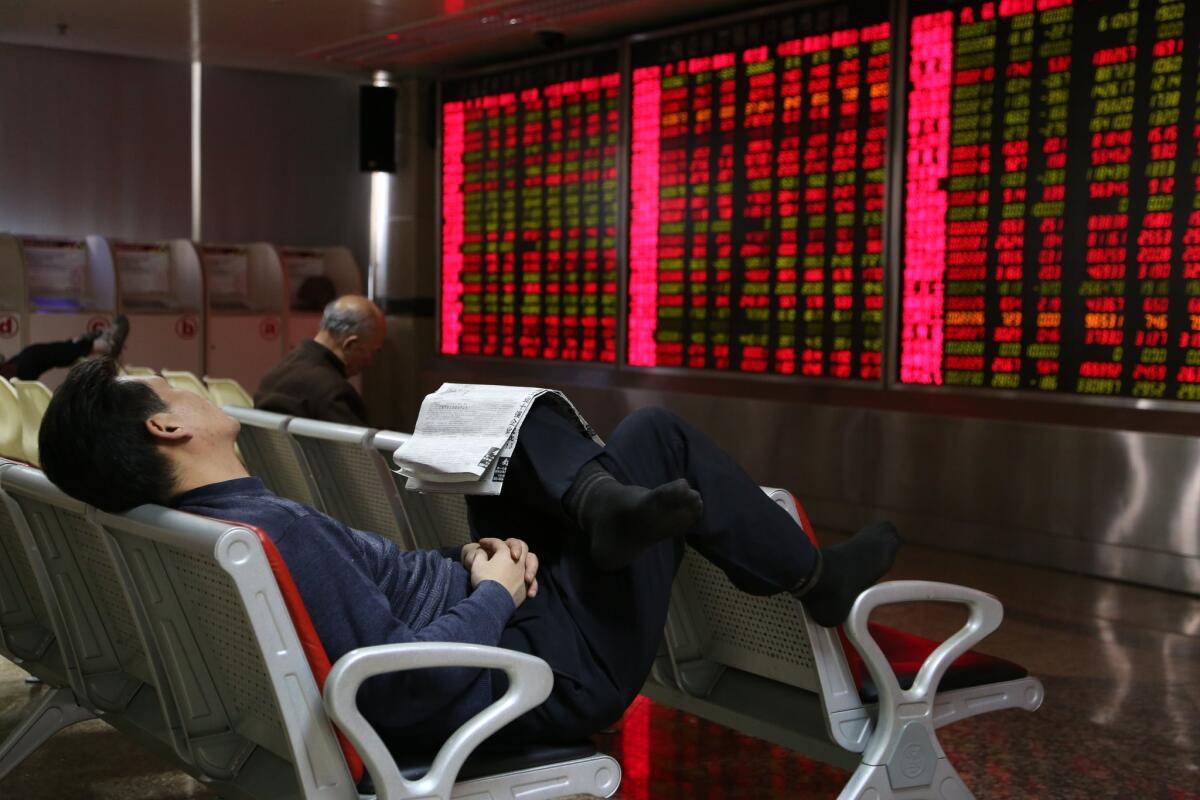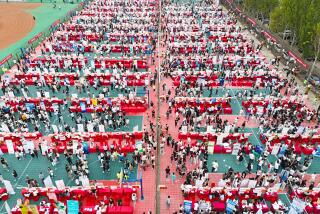As China’s economy slows, workers feel the sting

An investor naps while observing stock prices at an exchange hall Friday in Beijing.
- Share via
Reporting from Shenzhen, China — Jack Shao watched as his young co-worker climbed onto the roof of their four-story factory and threatened to jump.
The worker sat on a small, decorative arch atop the pink tile building, his beige jacket stark against the blue sky. Below him, thousands of workers were gathered for a labor protest. Minutes before, they had been shouting, “Give us back our wages!” Now, they were imploring the man to step back.
It was late afternoon on a Friday, Dec. 18, and management at the G.Credit factory in Shenzhen, a huge, gritty city in Guangdong province, China’s manufacturing heartland, had just informed its 2,600 employees that they wouldn’t receive their monthly wages on time.
The 6-year-old company assembled smartphones and other products for Huawei, Samsung, Motorola and other prominent firms — and now, apparently, it couldn’t afford to pay its workers.
Shao, 35, was overcome with anxiety. In 2010, when he was working at a factory in the nearby city of Dongguan, he witnessed a massive labor protest, which dispersed only after police fired live rounds into the air. But he’d never seen a suicide.
“I knew him by his face, but don’t remember his name. He worked on a production line,” Shao said. “He stayed up there for five or 10 minutes. Then he came down.”
China’s once red-hot growth is cooling, and G.Credit’s financial woes — and subsequent worker protests — underscore the slowdown’s tremendous human costs.
Scores of factories in manufacturing centers such as Shenzhen — a city of 10 million that is often called “the world’s factory floor” — have closed in recent months. Mobile phone manufacturers have ranked among the hardest hit, squeezed by rising competition and falling demand.
About 13 major electronics manufacturers in Shenzhen failed in 2015, according to the Shanghai-based financial newspaper National Business Daily.
The speed and intensity of the downturn has caught many observers off guard.
On Monday, investors seized on a downbeat report — the Caixin Purchasing Managers’ Index — as an indication that the manufacturing sector might be slowing faster than government statistics have shown. That day, China’s benchmark Shanghai composite index fell 6.9% to 3,296.66, its lowest level in nearly three months, after triggering a “circuit-breaker” that shut down trading for the day.
On Thursday, it plunged another 7%, causing the suspension of trading again.
Experts say that China’s labor rights laws are seldom well-enforced, and that factory closures can be messy, unpredictable and sometimes violent.
“We’ve seen no indication that things are getting any better,” said Geoffrey Crothall, a Hong Kong-based spokesman for the nonprofit China Labor Bulletin. “In Guangdong in particular, we’ve seen over the past two or three months in particular an increase in the number of labor protests, strikes and labor unrest in general. As factories continue to close down, the manufacturing sector continues to contract; all these issues which have remained dormant and unresolved for decades on end are now coming to a head.”
Even Apple has felt shock waves from the downturn. On Wednesday, the Japanese financial newspaper Nikkei reported that the electronics giant might cut back iPhone orders amid a slump in demand. According to the Wall Street Journal, provincial Chinese authorities have given its primary supplier, Foxconn Technology Group, $12 million in subsidies to minimize layoffs.
The causes of China’s downturn are wide-ranging and complex. Beijing’s leaders are struggling to shift economic power from state planners to consumers, and the country’s real estate sector is burdened by massive over-investment. “China grew faster and for longer than any other country in recorded history — they were already in uncharted territory,” said Nicholas Lardy, a senior fellow at the Peterson Institute for International Economics. “Some slowdown was inevitable.”
On Thursday night, Shao, wearing a crisp white shirt and blue windbreaker, sat in a McDonald’s reminiscing over his long and turbulent history in Shenzhen.
Since 2008, when he left his hometown in the far-away eastern province of Jiangxi, he has worked as a production coordinator, acting as an intermediary between a factory’s suppliers and assembly lines. For years, he worked seven days a week, 12 hours a day, running constantly between his computer and the factory’s assembly lines. One of his employers produced plastic Winnie the Pooh keychains; another made transformers for laptop charging cords.
We’ve seen no indication that things are getting any better.
— Geoffrey Crothall, a Hong Kong-based spokesman for the nonprofit China Labor Bulletin
When Shao joined G.Credit in 2013, he considered it his lucky break. He earned about $500 per month and had full weekends off, which he would spend in Dongguan with his wife and 5-year-old son. He would cook them dishes from their hometown — spicy stir-fried pork, braised fish with chili peppers — and accompany them on long walks in the park.
“Life was really good — even my relationship with my colleagues was good,” he said.
Then in mid-December, things took a turn for the worse. G.Credit’s chairman Liu Chaoqiang called a few dozen high-ranking employees together, Shao among them, and warned them of impending difficulties. The factory was deeply in debt.
He tried to raise their spirits by showing them a clip from a Chinese wartime drama. Shao remembered one line best: “It’s not that we weren’t brave,” one character said. “It’s that we ran out of bullets.”
Things came to a head Dec. 18, when G.Credit sent an email to employees notifying them that their paychecks were delayed. Workers gathered outside the factory, demanding arrears. Police arrived; Shao’s colleague climbed up, then down from the ledge; and a local government representative promised that the workers would be paid. The protest dispersed about 5:20p.m., and on Monday, many employees returned to work.
Yet tensions continued to simmer, and erupted into at least three additional protests in following days.
On Dec. 25, which is not a holiday in China, a representative from Shenzhen’s Longgang district government gathered workers in the morning to tell them that G.Credit had declared bankruptcy and voided their contracts. That afternoon, several of G.Credit’s suppliers — manufacturers of plastic moldings, cardboard boxes and other products — protested outside the factory gates, waving banners that read, “We also need to survive.” Police were dispatched to prevent looting.
On Dec. 28, hundreds of workers staged two separate protests outside district and city government offices seeking compensation for still-unpaid wages. Police arrested four people, who were later released, Shao said.
Local officials have since partially compensated several workers.
Alarmed by the unrest, authorities in Guangdong have launched a crackdown on labor activism in recent months, detaining and interrogating scores of nonprofit leaders. Seven activists remain behind bars; none could be reached for comment. One Shenzhen-based labor activist, Zhang Zhiru, declined an interview request, saying authorities had tapped his phone.
Crothall called these activists a “voice of reason” in labor disputes. “You take that voice of reason out of the equation, and yep, you can safely guarantee there will be more violence and police crackdowns,” he said.
Many former G.Credit workers reached by The Times said they are still seething at the closure.
Li Hongmei, 25, from Guangxi province, tested circuit boards in the factory for a few months before it closed. “I had no spare time, no entertainment, no personal life at all,” she said. “They didn’t even provide hot water! I’ve worked for several big companies in Shenzhen and I’ve never known a company that doesn’t have a water boiler.”
She said that she has returned to her hometown, and that the factory still owes her about $300.
Analysts say workers have been leaving Shenzhen in droves. “In Guangdong province the government is trying to push the economy to go more upscale — more high-tech, more services,” said Jonathan Isaacs, a Hong Kong-based partner at the multinational law firm Baker & McKenzie who focuses on labor issues in China. “They’re not really encouraging low-end manufacturing anymore. So unskilled workers … might have difficulties affording to stay in Guangdong.”
Shao said he plans to stick around — he recently found a new job as a warehouse manager at a monitor manufacturer. Yet he’s unhappy with his salary, and no longer gets to spend full weekends with his wife and son. He says G.Credit still owes him about $1,200.
“I don’t know if I’ll ever get my money back,” he said, his eyes cast down. He added that he no longer holds out hope for a stable, flexible factory job. “Although they [feel] sudden, we’ll see more factory closures,” he said. “I think I’ll encounter the same thing again.”
Times staff writer Jim Puzzanghera in Washington and Nicole Liu, Alexandra Li, Yingzhi Yang and Tommy Yang in The Times’ Beijing bureau contributed to this report.
Follow @JRKaiman on Twitter for news from Asia.
ALSO
No winning Powerball tickets sold; jackpot hits $1.3 billion
‘El Chapo’ met with actor Sean Penn months before recapture, Rolling Stone magazine says
Roger Goodell says NFL stadium proposals are not viable in Oakland, St. Louis and San Diego
More to Read
Sign up for Essential California
The most important California stories and recommendations in your inbox every morning.
You may occasionally receive promotional content from the Los Angeles Times.













